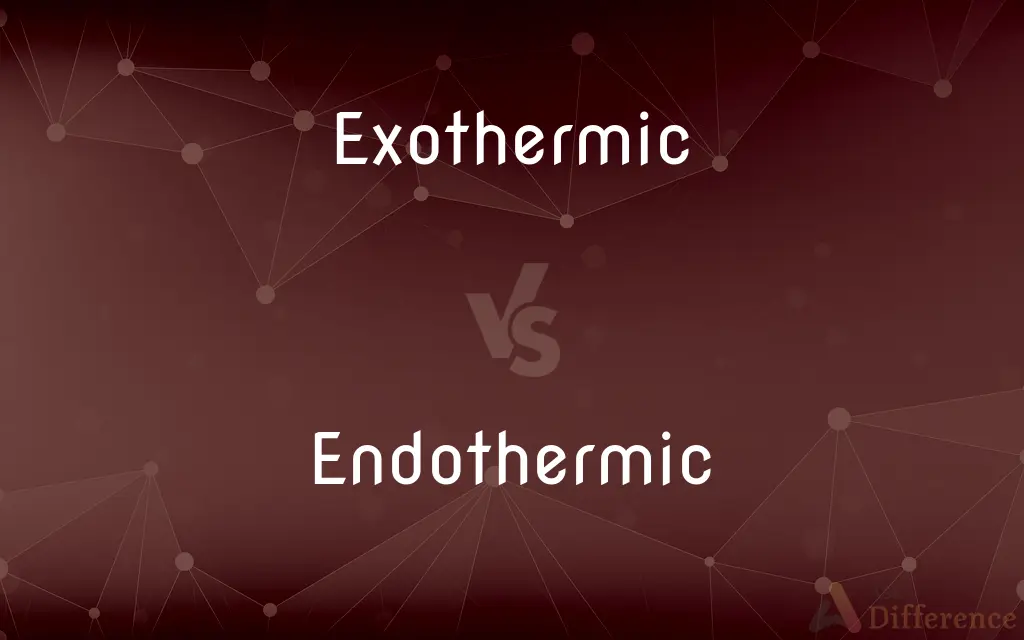Exothermic vs. Endothermic — What's the Difference?
Edited by Tayyaba Rehman — By Urooj Arif — Updated on April 20, 2024
Exothermic reactions release heat, often resulting in a temperature increase, while endothermic reactions absorb heat, causing the surrounding environment to cool.

Difference Between Exothermic and Endothermic
Table of Contents
ADVERTISEMENT
Key Differences
Exothermic reactions involve the release of energy, primarily in the form of heat, making the surroundings warmer. This is typical of many combustion processes, such as burning wood or coal. On the other hand, endothermic reactions absorb energy from their surroundings, typically leading to a decrease in temperature, as seen in processes like photosynthesis.
In exothermic reactions, the total energy of the products is less than the total energy of the reactants, meaning energy is released to the environment as heat. Whereas in endothermic reactions, the energy of the products is higher than that of the reactants, indicating that energy is absorbed from the environment during the reaction.
Examples of exothermic processes include the reaction of acids with bases, and the setting of cement or concrete. In contrast, the melting of ice or the evaporation of water are endothermic processes, requiring energy input to proceed.
The practical applications of exothermic reactions are extensive, including in heat generation for homes and industrial processes. Conversely, endothermic reactions are utilized in applications such as cooling, like in endothermic sports injury packs that absorb heat to reduce swelling.
The study of thermodynamics in chemistry extensively covers exothermic and endothermic reactions, explaining not only the energy changes but also their implications on reaction spontaneity and equilibrium.
ADVERTISEMENT
Comparison Chart
Energy Flow
Releases heat to the environment
Absorbs heat from the environment
Temperature Effect
Increases surrounding temperature
Decreases surrounding temperature
Energy of Products vs. Reactants
Lower than reactants
Higher than reactants
Common Examples
Combustion, acid-base reactions
Photosynthesis, ice melting
Practical Uses
Heating, explosive reactions
Cooling, chemical cold packs
Compare with Definitions
Exothermic
Combustion.
Combustion of coal in a power plant releases heat, powering steam turbines.
Endothermic
Photosynthesis.
Photosynthesis is an endothermic reaction, absorbing sunlight to convert CO2 and water into glucose.
Exothermic
Energy Release.
Exothermic reactions in hand warmers provide heat by oxidizing iron.
Endothermic
Ice Melting.
Melting ice absorbs heat from the environment, an endothermic process.
Exothermic
Spontaneity.
Exothermic reactions are often spontaneous, requiring no energy input to continue.
Endothermic
Cooling Effect.
The cooling effect of an endothermic reaction is utilized in instant cold packs.
Exothermic
Thermic Response.
The thermic response of an exothermic reaction can be felt as warmth emitted from the reaction site.
Endothermic
Energy Absorption.
Endothermic reactions in a sports injury pack absorb heat to reduce swelling.
Exothermic
Acid-Base Reaction.
Mixing hydrochloric acid with sodium hydroxide releases heat in an exothermic reaction.
Endothermic
Non-spontaneity.
Endothermic reactions typically require continuous energy input to proceed.
Exothermic
Releasing heat
An exothermic reaction.
Endothermic
(Chemistry) Characterized by or causing the absorption of heat; endoergic.
Exothermic
That releases energy in the form of heat.
Endothermic
(chemistry) Of a chemical reaction that absorbs heat energy from its surroundings.
Exothermic
That releases heat during its formation, and absorbs it during its decomposition.
Endothermic
(zoology) Of an animal whose body temperature is regulated by internal factors.
Exothermic
Characterized by, or formed with, evolution of heat; as, an exothermic reaction; - opposed to endothermic.
Endothermic
Designating, or pert. to, a reaction which occurs with absorption of heat; formed by such a reaction; as, an endothermic substance; - opposed to exothermic.
Exothermic
(of a chemical reaction or compound) occurring or formed with evolution of heat
Endothermic
(of a chemical reaction or compound) occurring or formed with absorption of heat
Common Curiosities
What is an example of an endothermic reaction in nature?
An example in nature is photosynthesis, where plants absorb sunlight to transform CO2 and water into oxygen and glucose.
How are endothermic reactions used in everyday products?
Endothermic reactions are used in products like chemical ice packs, which absorb heat to provide cooling.
Can you give an example of an everyday exothermic reaction?
An everyday example of an exothermic reaction is the burning of natural gas in a stove to cook food.
What is a common use of exothermic reactions in industry?
Exothermic reactions are used to generate heat for processes like metal smelting and glass making.
Why do exothermic reactions often feel hot?
Exothermic reactions release heat into their surroundings, making them feel hot to the touch.
What is the main difference in energy changes between exothermic and endothermic reactions?
Exothermic reactions release energy, while endothermic reactions absorb energy.
How do temperature changes affect these reactions?
Temperature increases can promote exothermic reactions and inhibit endothermic ones, while decreases have the opposite effect.
What safety considerations are there for exothermic reactions?
Exothermic reactions can be hazardous due to their heat release and potential for explosions in confined spaces.
Why are endothermic reactions important for environmental control?
They are used in technologies like air conditioners and refrigerators to absorb unwanted heat.
How does the law of conservation of energy apply to these reactions?
Energy is neither created nor destroyed in these reactions; it is merely transferred from or to the environment.
How do these reactions affect the environment around them?
Exothermic reactions raise the temperature of their surroundings, while endothermic reactions lower it.
What role does the energy of reactants play in these reactions?
In exothermic reactions, reactants have more energy, which is released; in endothermic reactions, reactants absorb energy to reach a higher energy state.
Are all combustion reactions exothermic?
Yes, all combustion reactions are exothermic as they release heat.
What educational concepts are important for understanding these reactions?
Understanding enthalpy, entropy, and Gibbs free energy is crucial for comprehending how these reactions occur and their impacts.
What is required to sustain an endothermic reaction?
Continuous energy input from the environment is required to sustain an endothermic reaction.
Share Your Discovery

Previous Comparison
Markt vs. Market
Next Comparison
Move vs. GoAuthor Spotlight
Written by
Urooj ArifUrooj is a skilled content writer at Ask Difference, known for her exceptional ability to simplify complex topics into engaging and informative content. With a passion for research and a flair for clear, concise writing, she consistently delivers articles that resonate with our diverse audience.
Edited by
Tayyaba RehmanTayyaba Rehman is a distinguished writer, currently serving as a primary contributor to askdifference.com. As a researcher in semantics and etymology, Tayyaba's passion for the complexity of languages and their distinctions has found a perfect home on the platform. Tayyaba delves into the intricacies of language, distinguishing between commonly confused words and phrases, thereby providing clarity for readers worldwide.














































